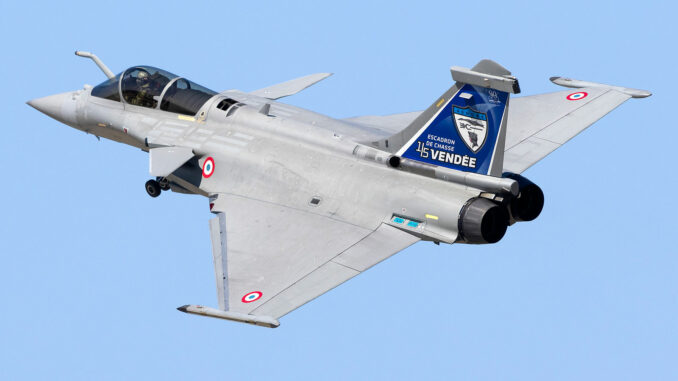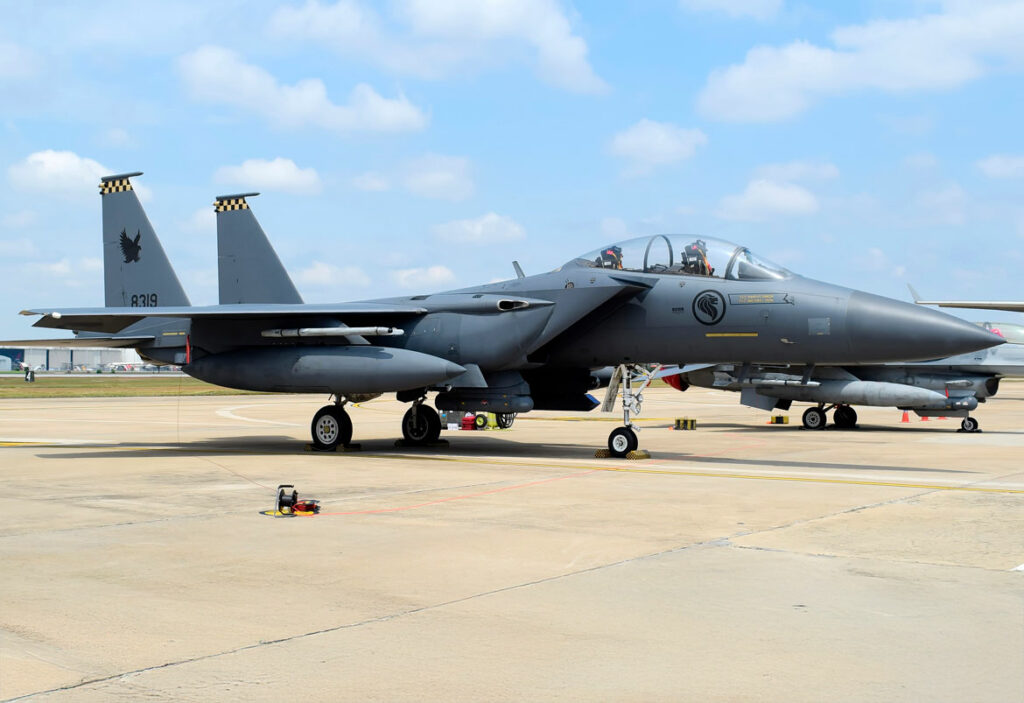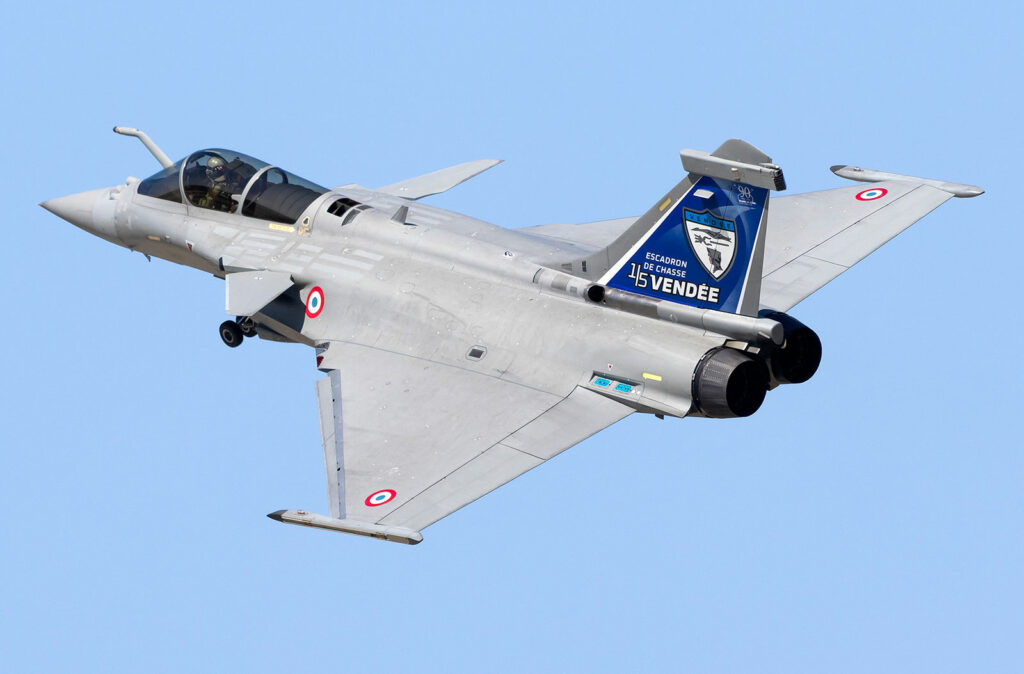
Multi-role aircraft: analysis of technical, logistical, and tactical limitations in the face of the operational realities of modern, high-intensity conflicts.
In modern fighter aviation, the term “versatility” refers to an aircraft’s ability to perform multiple types of missions without changing platforms. A multi-role aircraft can theoretically perform air interception, ground attack, tactical reconnaissance, and even electronic warfare, depending on its weapon and sensor configuration. This capability requires rapid adaptation to different operational contexts, often with a single aircraft, a single pilot, and a single sortie.
Since the 1980s, most new generations of fighters have incorporated this requirement. The French Rafale, the American F-35, the Swedish Gripen, and the Eurofighter Typhoon were all designed to meet flexible engagement doctrines. For military leaders, the advantage is clear: a multi-role aircraft reduces the need for specialized fleets, limits logistics costs, and allows for rapid action in complex and sometimes unpredictable theaters of operation.
But this logic of optimization raises questions. From a technical standpoint, versatility often involves trade-offs: limitations in terms of payload, the need to carry competing pods, increased fuel consumption, and accelerated wear and tear. Operationally, the ability of a single aircraft to successfully complete two very different types of missions in a single sortie remains a matter of debate. Finally, operational experience suggests that the multi-role doctrine may be effective in some theaters but less suitable in others, particularly in high-intensity contexts.
The central question therefore remains: is the versatility of fighter aircraft, as advertised, really applicable in real warfare, or does it remain a technical promise driven by industrial and budgetary imperatives?
The promise of multi-role aircraft: definition, history, doctrines
The idea of an aircraft capable of performing multiple military missions is not new. The F-4 Phantom II, which entered service in the 1960s, was one of the first fighters designed to operate in interception, ground attack, and reconnaissance roles. Although initially developed as an interceptor for the US Navy, it quickly became a multi-role aircraft for the USAF and the Marine Corps. However, its versatility was limited by the technologies of the time: weapon configurations had to be changed on the ground, and missions were generally distinct depending on the sortie.
In the following decades, doctrines gradually evolved towards standardization of onboard capabilities. In the 1990s, France opted for the Rafale, a fighter designed from the outset as an “omnirole” aircraft: capable of performing several types of missions during the same flight, according to a doctrine of maximum flexibility. For its part, the United States developed the F-35 Lightning II with the ambition of providing all its forces (Air Force, Navy, Marines) with a single aircraft suitable for different types of operations, including stealth.
From an industrial standpoint, this approach makes sense from a rationalization perspective: reducing development costs, sharing spare parts, and simplifying pilot and mechanic training. For the armed forces, multi-role capabilities are supposed to offer greater responsiveness with fewer aircraft.
In practice, however, multi-role capabilities remain subject to constraints. Payload, active sensors, aerodynamic configuration, and fuel capacity do not always allow for the effective completion of several successive missions in a single sortie. Aircraft are often preconfigured for a single specific mission per sortie. As a result, theoretical versatility is often limited by tactical choices, ground logistics, and mission requirements.

Ability to perform multiple missions: between theory and theater of operations
The missions that a multirole fighter aircraft is expected to be able to perform include interception and air superiority (air-to-air), tactical strikes against ground targets (air-to-ground), optical or radar reconnaissance, and, in some cases, electronic warfare. On paper, an aircraft such as the Rafale can theoretically carry MICA air-to-air missiles, AASM guided bombs for ground attack, a Damoclès or Talios designation pod for reconnaissance, and a Spectra jamming pod for electronic warfare. However, this complete configuration remains rare in actual operation.
The first limitation is payload. An aircraft can only carry a certain weight of weapons, sensors, and fuel. When loaded for multiple types of missions, it quickly reaches its structural limits. For example, a Rafale in deep strike configuration with three additional fuel tanks has considerably reduced maneuverability in air combat. Similarly, carrying several pods (laser designation, electronic warfare, reconnaissance) competes with the available mounting points and can limit the aircraft’s agility or endurance.
The second constraint is the incompatibility between certain pieces of equipment. The Talios reconnaissance and designation pod can occupy the same position as other equipment needed for electronic warfare. This forces planners to make choices even before the mission. It is therefore rare for an aircraft to take off with full multi-role capability, unless operational compromises are accepted.
In the field, feedback confirms these limitations. In Libya (2011), French Rafale aircraft mainly carried out air-to-ground and reconnaissance missions, rarely in combination. In Iraq and Syria, coalition F-16s alternated between air-to-air protection and air-to-ground bombing configurations, rarely both at the same time. As for the F-35, its use in Syria by the US Air Force was initially limited to reconnaissance and precision strike missions in uncontested areas, before a ramp-up was considered.
In practice, a multirole aircraft only performs one role at a time per sortie. Versatility is demonstrated by the ability to quickly reconfigure the aircraft between missions, not by doing everything in a single flight.
Versatility vs. specialization: performance in direct confrontation
The central question that pits multirole aircraft against specialized aircraft is that of performance in high-intensity situations. In a context where air superiority, survivability, and precision are critical, can the same level of effectiveness be achieved with a multirole aircraft as with an aircraft designed for a single mission? Comparisons between models illustrate different doctrinal choices and raise tensions between flexibility and raw performance.
Take the case of the F-15C Eagle, designed for air superiority, and the F-15E Strike Eagle, a two-seat multi-role version capable of precision strikes while retaining some air-to-air capability. Structurally, the F-15E is heavier, less agile in turning combat, and often relies on air-to-air radar that is less effective than that of some versions of the F-15C. It can carry more fuel and air-to-ground weapons, but this comes at the expense of maneuverability and range at supersonic speeds. In pure air combat, at equivalent weight, the F-15C retains an advantage.
The French case also illustrates this contrast. The Mirage 2000D, optimized for ground strikes, has a slim and fast airframe, but is limited in air-to-air capability and is not compatible with the latest generations of active guidance missiles. Conversely, the Rafale, designed as an omnirôle (multi-role) aircraft, is capable of carrying out all missions in theory, but remains subject to trade-offs in flight: for example, carrying heavy bombs penalizes its ability to engage in prolonged air-to-air combat due to a lack of agility and available fuel.
In high-intensity scenarios—i.e., in the presence of advanced ground-to-air defenses, modern enemy aircraft, and heavy logistical pressure—specialized aircraft retain targeted and often superior effectiveness in their field. Multirole aircraft, on the other hand, must be lightened or reconfigured to maximize their effectiveness on a specific task, thereby losing their supposed versatility. Flexibility is useful for planning long campaigns, but each mission imposes operational constraints that reduce the ability to do everything effectively in a given situation.
Limiting factors: logistics, maintenance, and airframe fatigue
Beyond flight performance, the versatility of a fighter aircraft faces concrete limitations related to logistics, maintenance, and airframe wear. In real-world operations, these factors directly affect a fleet’s availability, its ability to be engaged over time, and the sustainability of the multi-role model within a constrained budget.
The maintenance in operational condition (MOC) of a multi-role aircraft is more complex than that of a specialized aircraft. There are more sophisticated onboard systems, which must be maintained within short timeframes. According to a 2023 report by the Government Accountability Office (GAO), the F-35A has an overall availability rate of less than 55%, mainly due to the complexity of its ALIS logistics system and the density of its onboard sensors. The Eurofighter Typhoon, also a multi-role aircraft, has availability rates that vary greatly between user countries, averaging between 50% and 70%. In comparison, simpler aircraft such as the F-16 or Mirage 2000 often have availability rates of over 75%.
Operational versatility also leads to accelerated wear and tear on airframes. An aircraft that flies repeatedly at low altitude for ground strikes, then high-altitude interception missions, places different demands on its structure and onboard systems. Feedback from the French Air Force indicates that the Rafale aircraft deployed in the Sahel have had their airframes subjected to flight cycles that are very different from those originally planned, increasing maintenance requirements.
Finally, the Israeli Air Force (IAF) and US Air Force (USAF) emphasize that the intensive use of multirole aircraft in theaters such as Syria and Iraq requires significant logistical mobilization, with specialized teams needed to reconfigure the aircraft between missions. These constraints ultimately limit the speed of re-engagement and the promise of total flexibility.

Concrete cases of asymmetric vs. high-intensity conflicts
Recent conflicts provide a concrete basis for analyzing how multi-role fighter aircraft are used and reveal the difference between their stated versatility and their operational application. Three major theaters allow us to compare these uses: the Serval and Barkhane operations in the Sahel and Inherent Resolve in the Middle East.
During Operation Serval (2013) in Mali, the Rafale was used for ground support, tactical reconnaissance, and occasional interception missions. The asymmetric nature of the conflict, against non-state armed groups with no structured air defense, facilitated the flexible use of multirole aircraft. However, even in this favorable context, the Rafales generally performed only one type of mission per sortie: a strike, reconnaissance, or escort. The Talios laser designation pod was used on some aircraft, while others carried air-to-air missiles in a defensive configuration. Adaptations between missions required reconfigurations on the ground, with significant logistical delays.
In Barkhane (from 2014), constraints became more severe due to the length of deployments. The aircraft flew long rotations with asymmetrical loads (external tanks, guided bombs, pods), but the multiple missions were always carried out in sequence rather than simultaneously. The speed of reconfiguration between two types of mission depended heavily on the presence of ground crews and well-organized stocks of ammunition and pods at forward bases.
As part of Operation Inherent Resolve, F-16, F-15E and later F-35 aircraft were deployed to strike Islamic State targets in Iraq and Syria. Again, versatility was more a matter of rapid re-assignment between missions than an actual ability to carry out multiple actions in a single sortie. The F-15E, for example, configured for a strike, was not in an optimal position for air-to-air combat. In addition, strict rules of engagement and inter-allied coordination limited tactical improvisation.
These cases show that multirole capability is effective in asymmetric conflicts, provided that the ground-to-air threat is low and logistical support is robust. However, in a high-intensity context—for example, against an adversary equipped with advanced air defenses—the need for specialization and precise configuration of each aircraft becomes a priority once again. The versatility demonstrated therefore remains largely dependent on the type of conflict and the resources available on the ground.
A final word
The versatility of fighter aircraft, often presented as a decisive advantage, appears on analysis to be more of a tactical compromise than a genuine universal asset. In terms of doctrine, the ability to perform multiple missions with a single type of aircraft does indeed simplify fleet management, reduce training and logistics costs, and offer a degree of operational flexibility. This flexibility has proven useful in recent asymmetric conflicts, such as in the Sahel and the Middle East, where threats were limited and predictable.
But when considering more complex scenarios in high-intensity contexts, the technical limitations become apparent. The configuration of each aircraft remains crucial: payload, available pods, fuel consumption, and aerodynamic performance impose strict trade-offs. A multi-role aircraft is not automatically capable of fulfilling multiple roles in a single sortie, and its effectiveness depends largely on the logistical resources available on the ground, reconfiguration times, and mission constraints.
From a budgetary standpoint, versatility remains attractive to governments. It allows programs to be pooled and acquisitions to be optimized. However, operational realities often require the maintenance of a complementary fleet, with specialized aircraft for certain critical missions (electronic warfare, intelligence, heavy interception).
Avenues for development include the increasing integration of onboard intelligence, the use of modular platforms that can be adapted in flight, and the coordinated use of specialized drones to support multirole aircraft. These hybrid solutions could make it possible to overcome the current limitations of the concept of versatility, while maintaining the responsiveness and coherence of air forces in a variety of theaters.